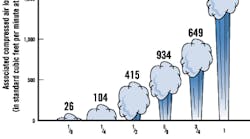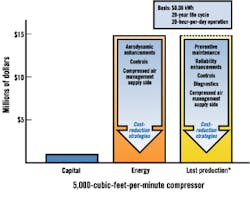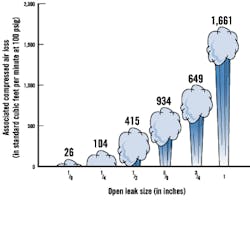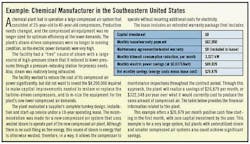Electric motors account for approximately 70 percent of the energy used by industry in the United States. Compressed air equipment consumes a large portion of this energy in many industries, including the chemical industry. By reducing the energy-related compressed air costs, chemical companies can save a significant amount of money.
Many of today's plants have outdated compressed air systems with inefficient equipment, obsolete controls and undersized piping. Such plants could realize as much as 25 percent savings in energy costs through the installation of newer equipment, controls and system components ," potentially boosting facility profitability.
Although numerous energy-improvement programs currently are being touted, many of these programs involve expensive retrofits. These retrofits can achieve significant energy savings, but they often bring with them a payback in the five- to seven-year range. Because most chemical facilities require a payback of less than two years, these types of energy conservation projects might never be implemented.
Plants can achieve real energy savings, however ," and circumvent at least some of the high capital cost expenditures ," through implementation of a five-step approach that stresses the identification of energy-savings opportunities and works within payback restraints. It is very common for plants to save a significant amount of energy without buying new compressed air equipment. This article details each of these steps.
Identify savings opportunities
Compressed air systems are often less understood than other utilities such as electricity, steam and chilled water, so in many plants these systems have been ignored for years. The result is that the compressed air system might be operating at much less than optimum efficiency.
Fig. 1 illustrates the typical life-cycle costs of a compressed air system.
Figure 1. Life-Cycle Costs of a Compressor
* The cost to the customer resulting from lost production can exceed both the capital and energy costs, and can be significant.
Although compressed air is a "mystery" to many engineers, the savings opportunities are huge, with approximately 90 percent of available savings coming from three broad areas, including:
Demand or consumption reduction. This most often is accomplished by controlling leaks and putting an end to improper use.
Compressor operating-pressure reduction.
Continuous monitoring and load management of the system using master control systems.
The first step in identifying savings opportunities calls for a complete review of the entire compressed air system. To accomplish this, the plant first should put together a compressed air team made up of representatives from the facility's engineering and maintenance staff, assuming these plant personnel have sufficient experience with compressed air systems. If significant compressed air system knowledge is not available on-site, the facility should consider hiring a consultant with the necessary system experience.
This team then should implement a complete compressed air system study that includes not only the compressor room equipment, but also the distribution system. In addition, it should take a look at how the compressed air is used.
This study should include an aggressive leak detection/elimination program and investigate existing demand-side system components that could be improved. Even small leaks or inefficiencies in the system can waste a substantial amount of energy. See Fig. 2.
Figure 2. Energy-Savings Opportunities
Specifically, the team should:
Evaluate the demand and energy consumption of compressed air usage.
Check system fittings. Are they the best choice for minimizing leaks?
Check point-of-use pressure regulation and filtration for proper control and pressure drop.
Examine system traps. Are they of a high-enough quality to prevent air loss?
Analyze pressure drop. Are the air dryers and filters optimized? Are pipe restrictions present? Is the piping sized correctly to provide low pressure drop? (See http://air.inger soll-rand.com/AST/piping.htm for some piping tips.) Remember: Each 1 psig in pressure drop is equivalent to as much as a 1/2 percent change in the total energy required. For example, a 4,000-horsepower (hp) compressor system operating 10 psig higher than necessary as the result of excessive pressure drops could be consuming as much as 5 percent, or 200 hp, more than necessary. This means more than $65,000 in wasted energy at $0.05 per kilowatt-hour (kWh) of electric power, 8,500 hours per year operation and 95 percent motor efficiency.
Look at compressor operation and plant needs. Are the compressors operating at their lowest possible pressures? Are they being shut off when not needed?
Compressed air systems normally must operate within a fixed pressure range and deliver a varying air volume, based on demand. Control systems are necessary to monitor system pressure and to automatically decrease or increase compressor output when the pressure reaches a specific level.
By examining the plant's existing control strategy, the team will be able to determine if the approach is really the most suitable ," or if another alternative would make more sense. Therefore, the team should scrutinize all aspects of controller functions, including pressure control, surge/valve control and health monitoring, data transfer and storage, asking:
Is the compressed air demand constant like a process load, or does it vary widely?
Does the compressed air system have a master control system that looks at system demand? Does the control system include load-sharing and start/stop capabilities? Master control systems can offer significant savings with relatively low investment.
Are the controls obsolete? Many systems currently are operating with obsolete controls that cannot achieve the savings of today's microcontroller-based control systems.
Master control systems can save large amounts of energy. For example, a chemical company in the Southeastern United States ran a quick test to see how much energy the new master control system was saving its facility. They recorded motor amps with the master system engaged, and then recorded the amps with the system disengaged. At the same system demand, the master control system was saving them approximately 800 kW, which amounted to $238,000 per year. This translated into a three-month payback on a less-than-$50,000 master control system.
Another chemical company was able to shut off a 1,250 hp compressor when it installed a master control system. This system paid for itself in one year.
Identify equipment needs
After the team makes all possible minor improvements identified under the first step, it then must consider what major improvements really are necessary. It should carefully examine the equipment and control options currently available.
If the compressor equipment itself is not performing efficiently, it might be time to consider some capital expenditures in this area. To do this, it is helpful to take a look at the types of compressors and related equipment currently available. Some examples include:
The addition of new aerodynamic hardware to existing machines. In some cases, the hardware brings about an 8 percent to 10 percent efficiency improvement over older compressors.
Newer air dryer technologies, which might offer significant reductions in purge rates and energy consumption over existing air dryers.
Better inlet filtration, which might reduce the contaminants entering the machine, thereby decreasing the frequency of overhauls.
The addition of high-quality condensate traps. Some systems operate with a continuous blowdown of condensate through v-notch ball valves. High-quality condensate traps can significantly reduce air and energy loss through the condensate system.
Variable-speed drives, which might offer large energy savings on systems using rotary screw compressors.
In addition, if production demands have changed over time, the compressors might be oversized. In cases such as this, a smaller trim compressor or additional compressed air storage might be needed to reduce energy consumption.
If the plant has unused steam that is either being blown off or let down stations, a steam-turbine-driven compressor might allow a motor-driven compressor to be shut down. If the steam pressure is being reduced through a valve, the team might want to consider using a turbine-driven compressor as the reducing station. Or perhaps the team might want to evaluate the feasibility of a gas-engine-driven compressor that uses natural or landfill gases to slash energy costs.
Justify the project
After the team identifies energy-savings opportunities, performs minor adjustments and determines equipment- and control-related needs, it must justify all capital expenditures, making sure they bring to the table a timely payback within the company's return-on-invested-capital guidelines.
If the team determines it can make the designated improvements and still achieve the desired payback, great. If the payback period is too lengthy, however, it might want to consider alternatives to capital purchases. Even if the payback period is acceptable, the team will want to evaluate its purchasing scenario against other alternatives, as detailed in the next step.
Consider alternatives
Customized energy solutions are available that allow chemical and other facilities to lease the desired equipment, with the turnkey design, installation and startup provided by the supplier. Some programs include an extended warranty package that provides preventive maintenance inspections and warranty throughout the contract period.*
These types of programs might require no capital investment on the part of the customer, and allow a positive cash flow in the first month of operation. The sidebar provides one real-life example of how this type of program can benefit chemical-industry customers.
Verify results
Once the team has installed the new equipment or entered into an equipment-related lease agreement, it should begin tracking its savings. The best way to verify results is by installing flow and kW monitoring equipment as part of the project. This allows the team to monitor demand and energy consumption over time. After all, the use of this expensive utility cannot be managed unless the team knows how much is being used and what it costs the plant each month.
Conclusion
When it comes to cutting compressor-related energy costs, no one solution fits all chemical facilities. By following the five-step approach detailed here, however, the plant can identify and implement the solution(s) that will work best for its individual needs and capital budget.
Watson and Scutella work in Ingersoll-Rand Co.'s HIS Air Solutions Group, Davidson, N.C. Contact them at [email protected] and kristen_ [email protected], respectively.
*Ingersoll-Rand is one company that offers such a program.





